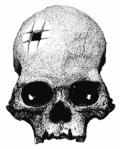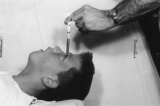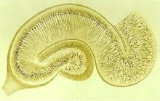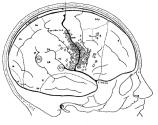THE perception and recognition of faces is crucial for the social situations we encounter every day. From the moment we are born, we prefer looking at faces than at inanimate objects, because the brain is geared to perceive them, and has specialized mechanisms for doing so. Such is the importance of the face to everyday life, that we see faces everywhere, even when they are not there.
We know that the ability to recognize faces varies among individuals. Some people are born with prosopagnosia, the inability to recognize faces, and others acquire the condition as a result of brain damage. At the other end of the scale are people who never forget a face - the so-called "super-recognizers". Two independent studies published recently now provide strong evidence that the ability to recognize faces is largely inherited, and that it is passed on independently from intelligence and other cognitive functions.
The heritability of face recognition ability has never been investigated until now. There have, however, been a handful of studies of families in which many members have severe impairments in face recognition. (In some of these families, the affected individuals are also unable to recognize objects, while in others, object recognition remains intact.) This suggests that the ability to recognize faces has a genetic basis.
Both groups of researchers used the twin study approach, an experimental design used to investigate individual differences by teasing apart the relative contributions of environmental and genetic factors. As their name suggests, twin studies are used to make comparisons between the behaviours of pairs of identical (or monozygotic) twins, who share 100% of their genetic material, and non-identical (dizygotic) twins, who share only 50% of their genes. Researchers look for traits that show a greater similarity in identical than in non-identical twins, because this is indicative of a shared genetic basis for that trait.
One of the new studies, led by Jia Liu of Beijing Normal University in China, was published in the journal Current Biology in January. The researchers compared the performance of 102 pairs of identical twins with that of 71 pairs of non-identical twins, all aged between 7-19, on three different behavioural tests. Each of the tests was designed to separate face-specific neural processing from more general cognitive functions such as attention and decision-making, and each participant was tested individually by the experimenters at their school.
The first tested participants' memory for faces and houses (below left). Each pair of twins was first shown 20 images each category; 10 of these were then shown again, randomnly intermingled with 20 new images, and the participants were asked to determine whether or not they had seen each one before. The second tested their ability to recognize inverted faces (middle). Most objects are more difficult to remember when seen upside down, but faces are disproportionately affected. Finally, they were shown composite face images, each consisting of two different faces split horizontally and recombined (right). In this task, each half face in the composite is harder to identify when the two halves are aligned than when misaligned.
On all three tasks, performance was significantly more correlated between pairs of identical than non-identical twins. In other words, the scores of the identical twins were far more similar than those of non-identical twins. This was not because more identical twins were used, or because of the inclusion of opposite-sex twins. The same results were obtained when the number of twin pairs was matched, and when different sex twins were excluded from the analysis.
The second study, led by long-time prosopagnosia researcher Brad Duchaine of University College London and just published in Proceedings of the National Academy of Sciences, was slightly larger with a total of 289 twin pairs (164 identical and 125 non-identical twins). Duchaine and his colleagues used the Cambridge Face Memory Test, which involves first studying faces and then trying to recognize them when viewed from different angles and under different lighting conditions. As in the Chinese study, the correlation between the scores of identical twin pairs was much stronger than that between non-identical twins. By contrast, the scores of the identical twins on a verbal memory test and an abstract art memory test showed much greater variation.
Both of these studies strongly suggest that most of the variation in face recognition abilities can be accounted for by genetic factors, and that the perceptual mechnisms underlying the processing of faces - as opposed to the processing of other objects - is largely hereditary. This is of course supported by the case studies showing that impairments in face recognition can run in families. The new findings further suggest that face recognition ability is not strongly correlated with IQ, the crude measure of what we call intelligence, which is thought to be largely heritable. This means that intelligence and the ability to recognize faces are inherited independently of one another.
Differences in general cognitive abilities are thought to be due to the inheritance of "generalist" genes which affect different functions in a similar way. The new findings challenge this notion, as they provide evidence that specific cognitive abilities - such as the the ability to recognize voices or navigate one's environment - have "specialist" genes devoted to them. An example of a specialist gene is FOXP2, which is associated with speech and language functions in humans. FOXP2 was identified in studies of a large, multi-generational family known as KE, about half of whom have a speech and language deficit caused by a rare mutation in the gene.
Exactly how FOXP2 mutations lead to the deficit is not clear. It is known to encode a protein that regulates the activities of other genes during neural development, and although these target genes have not been identified, they are likely to be involved in wiring of the neural circuitry underlying speech and language. Genetic analyses of individuals with congenital prosopagnosia could yet lead to the identification of a gene involved in face recognition. A recent neuroimaging study showed that the structure and responses of face-selective visual cortex areas are more similar in identical than non-identical twins. This raises the possibility that a gene involved in face recognition might orchestrate development of the circuitry involved in visual perception.
Related:
- Developmental topographagnosia
- Neural basis of congenital face blindness
- First case study of developmental phonagnosia
Wilmer, J., et al. (2010). Human face recognition ability is specific and highly heritable. Proc. Nat. Acad. Sci. DOI: 10.1073/pnas.0913053107.
Zhu, Q., et al. (2010). Heritability of the Specific Cognitive Ability of Face Perception Curr. Biol. 20: 137-142 DOI: 10.1016/j.cub.2009.11.067.
Duchaine, B. & Germine, L. (2004). Family resemblance: Ten family members with prosopagnosia and within-class object agnosia. Cognit. Neuropsychol. 24: 419-430. [PDF]
Behrmann, M. & Avidan, G. (2005). Congenital prosopagnosia: face-blind from birth. Trends Cog. Sci. 9: 180-187. [PDF]
Yin, R. K. (1969). Looking at upside-down faces. J. Exp. Psych. 81: 141-145. [PDF]












